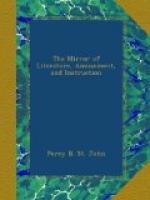“THOMAS SIMON most humbly prays
your MAJESTY to compare this his
tryal-piece with the Dutch, and if more
truly drawn and embossed, more
gracefully ordered, and more accurately
engraven, to relieve him.”
To any one but the heartless profligate whose portrait occupied the obverse of the medal, this appeal would have been irresistible, but it does not appear that the unfortunate artist was relieved. He probably died of grief and disappointment at the unjust preference shown to his rival.
James II.—The base money struck by James the Second, in Ireland, in 1689 and 1690, is common, except the crown of white metal, with the figure of James on horseback. Some of his half-crowns and shillings were struck of metal, the produce of old cannon, which were melted down for the purpose, and are in consequence termed “gun money.”
Anne’s Farthing.—The common current farthing of Anne is scarce, but scarcer with the broad rim. The patterns of 1713 and 1714 are rare, but those with the reverse of Britannia under a kind of arch, or with Peace in a car drawn by two horses, and the legend PAX MISSA PER ORBEM, are the scarcest of all.
At a public sale of the coins of the late Mr. Dimsdale, the banker, the Oxford crown with the city under the horse, was knocked down at sixty-nine pounds. At the same time the rial of Mary brought sixty-three pounds, and the rial of Elizabeth twenty-one pounds ten shillings.
A friend of the author is of opinion, that the coins of Henry VII., with the head in profile, are the first English money bearing a likeness of the sovereign.
[The work is illustrated with, several lithographic fac similia of coins; and the vignette is from a very beautiful gold coin of Hiero II. of Syracuse, in the possession of Mr. Till, of Great Russell-street, Covent-garden. This morsel of antiquity, not larger than one’s little finger nail, must be upwards of two thousand years old!]
[10] The groat of Edward I. sold
for five and a half guineas, at a
public sale in London, in March, 1827.
It is quite evident
that the effigies of the English monarchs
on their coins are not
likenesses, until the time of Henry
VIII. whatever the
Ingenious may say to the contrary. Some
have supposed that the
rude figures on the Saxon coins use likenesses,
but the idea
is ridiculous. Folkes, in his “Table
of English Silver Coins,”
remarks that the Kings of England are represented
bearded on
their great seals, but always smooth-faced
on their coins.
* * * * *
THE GATHERER.
* * * * *
The Red Sea.—The water of the Red Sea is so very clear, that Mr. Buckingham read on the wooden stock of an anchor the name of the ship at the depth of 25 fathoms (150 feet).




